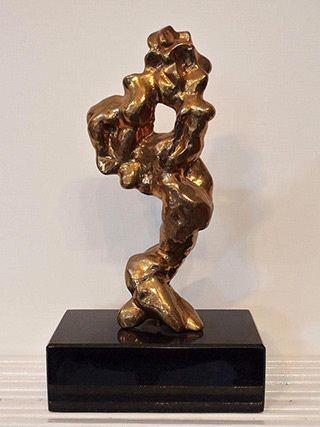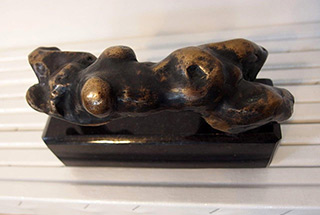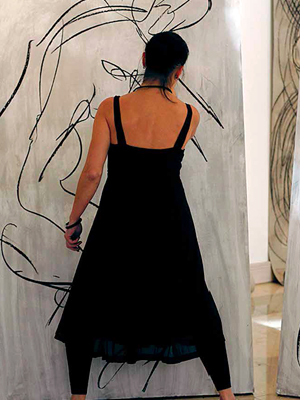Meetings with Aśka
In June 2012, in ZPAP [Association of Polish Artists and Designers] Gallery at Koński Kierat in Szczecin, I met Asia at an exhibition of her works and an artistic event named “The Act of Creation II”. The exhibition was also presented in May 2014 in the Art Gallery Zamek in Szczecinek, almost in the same form, under the name “The Act of Creation III”. The first instalment of this cycle took place in October 2011, in the Culture Centre in Chojna, under the name “The Act of Creation”, very obvious in terms of numbers chronology, but not so obvious artistically.
I also met Asia in September 2014, on the 22nd floor of a business skyscraper in Szczecin, in Café 22. There, Asia showed twenty works, painted on paper, under the common name “Body Landscapes”, hung opposite to panoramic windows with a broad view of the city.
For me, those were two important meetings, with two seemingly different projects. I have known Asia since she discovered in her first graphics and sculptures the old age riding on a nimble Indian horse. It was a long time ago and this type of experiencing events and sensing the future makes me suspect the simultaneous existence of multiple time dimensions. The distanced “Joanna Mieszko-Nita” would, therefore, have a false tone here. Her messages on my phone allow to draw a map of a free spirit constantly travelling through the world. I am a “close” person, seeing in her texts places bearing the names of many Polish and global cities, with Warsaw being the first of them, and as a “close” person, I also look at places where the artist-spirit stops for a moment, having taken the first step in her studio in Chojna.
Hell, dance, drawing
“The Act of Creation” – I am thinking: “creating of an act”, “creation – creating – act – body – man – naked – coal – ash – clay”. Word plays with their logic set out quite a broad space for associations, which, however, have their undisputed axioms, like poles carrying light wires under voltage. Thoughts which run in all directions, now return to the same paved central square: paradise. The place in the consciousness called paradise, what it is – we seem to know…
On high walls of the gallery, Asia has hung unrolled drawings, torn out of a roll of thick grey paper, drawn with a brush – the tool of calligraphy and painting. The thick, black path, here and there laid with whites, creates a fancy line, broken or lost again and again, making up an ornamental path without a beginning or an end.
In the interwoven curvatures, the eye recognizes only shapes of human figures – women, sometimes men: they freely fill up the plane vertically, they run down from the ceiling in decorative stripes like enormous arabesques, and they lie on the floor.
In these shapes, there is a subtly marked nakedness, the centre of the body, its general form with its volume and weight, a de-individualized head without a face, limbs without hands and feet – omitted, as if out of fear of getting lost in insignificant details. I hear the viewers, they say: erotic. I look again: this nakedness is not sensual. Collecting the ascending or falling (determination of the direction might not be important) bodies in a clear intention of a strongly acting erotic impulse proves unsuccessful. They remain very separate, in spite of the boldly intertwined lines. The bodies do not want to charm and appeal: even if the majority of female, as well as male nudes in the art has been created with the masculine, and in the present, partly “re-polarized” culture, feminine viewer “inscribed” into them, these show themselves as if the gender was only a differentiating sign and nothing more. Here we are, as humans, both men and women, but our bodies are levitating vertically in a rhythmic, not orgiastic, well-known structure of the fifteenth and the sixteenth century hells.
All images of Last Judgements, painted since long ago, with various literality and imaging dynamics, show hell: from the funny, cause naively architectonic vision of Fra Angelico in San Marco in Florence, the extreme right wing of the polyptych by Rogier van der Weyden in Beaune with the whirl of the condemned sinking into fire, through a similar, but broader concept in the triptych by Hans Memling in Bruges, then the fresco in the cathedral in Orvieto, where Luca Signorelli drew naked bodies using his knowledge of the anatomy and the foreshortening, after which came and from which born was Michelangelo with the great Last Judgment in the Sistine Chapel, and finally, to hells full of symbolic intricacies and grotesques in paintings by Hieronymus Bosch in Prado or Vienna. Contemporary visual arts do not like those old ones, where hell was part of the iconographic program with a determined order and the New Testament message about redemption of the humankind. The above mentioned context seems risky. We cannot know the extent to which the artist is aware playing with it, when she does not provide a clear suggestion of a movement downwards (which would be the hell of those struck down for their sins) or upwards (heaven of those justly elevated).
The suspension of the directed action of the figures, the happening of the story, makes us focus on semantic aspects of the drawing itself, which in the case of Asia resembles nudes almost directly taken from Michelangelo’s sketches. There, the pose, gesture, layout of a freely and monumentally drawn body are carriers of easily recognizable human emotions.
Asia shows us how her drawing is created and what it is. She draws her nudes in several minutes, using coal, on five large boards at the same time, to sounds of rhythmic music. Something like a trance dance, in which the maximum concentration and the noise help separate the body and the hand drawing the lines from the thinking head: between intuition and certainty, there is no place for slow conclusions. First, a premonition of an image of the body, the moment of decision, and then materialization of the image on a white surface – all this happens very fast, multiplied by five.
The drawings are intentionally sketch-like, the bodies are unfinished, arms miss hands and fingers reaching for something or grabbing something, legs miss feet to support them on the ground, heads – if any – miss faces: crying mouths, seeing eyes. Thus, these bodies cannot speak with their own feelings. Here and there, a drawing starts from secondary lines, determining correct proportions of individual parts and equally powerful in their expression as those most beautiful, characteristic for the shape of the shoulders, hips, thighs. Asia works out the form, sometimes “correcting” some lines multiple times or cutting out a figure out of the background by fast shading with black – like a sculptor, she adds volume to the figure, creates depth.
The lines recognizable in the chaos do not individualize the figures, on the contrary, they become very general: before the viewers’ eyes, a sign is created, identified as a naked person, a nude. To be precise, this is a suggested, unfinished, imperfect and incomplete sign, a person merely sketched by a human hand. Such is the created human here.
“The Act of Creation” – this title, however, emphasizes mainly the action itself, a movement, a creating or just creative gesture, repeated in successive scenes. What was created will, in a second, turn into coal dust, erased from the board. Whether perfect or broken, the man in the drawing, together with the four companions from adjacent boards, is worth only of a documentary photo. What counts is the moment of creation, spread upon individual rhythmical phrases: the viewers should focus on the creator. A girl in black, with naked feet, concentrated and participating with every inch of her body in the given moment, she is creating in a dance on the background of white surfaces. She is one with her work: between movements of the girl and the drawn lines, there is adequacy and balance. The dancer gives the lines speed, energy and joy, and the drawing expresses this joy and power, speaks with emotions of the drawing person, not the drawn one.
Calligraphies
The lines of a female body in fast strokes of a thick brush jostle the paper rectangles in large close-ups, thus the appropriate name for the series of works “Body Landscapes”. Headless torsos with graceful details – stomachs, arms, backs, thighs – alternating rhythms of dark blue and golden yellow strokes, with white added flat. Bodies suggested with subtly bent, but not contour lines, lose their weight.
I am looking at these non-painting paintings as if they were abstracts, and the aesthetic pleasure of viewing them increases even more. Asia’s paintings, so drastically reduced in the means of expression, show themselves to me somewhere between a pictogram, starting from real forms, and a calligraphic writing sign, into which the pictogram, separated from those forms, transforms itself. How particular are the rules of the art of calligraphy, where an abstract hand-written sign is compared with a human body, harmonious and proportional. In Asia’s works, the body heads towards the sign, assuming an ideal form, finding itself in the similarity to the human body. The superior principle of harmony and balance joins the brush, the type of paint (in calligraphy – ink) and the surface, and the drawn lines, strongly contrasting with the background, are the most important: they, instead of the space around them, create meanings. Therefore, calligraphy does not need colour. Asia still adorns her writing with some colour, but only lightly and sparely. This method, however, adds lots of musical quality to the described landscapes: melodic lines of stronger and weaker colours run parallelly, resonating with and adding to one another – clearly, without dissonance.
Lines drawn with the brush have their rhythm, speed and swing. In spite of the motionlessness of the presentation, the hand movement is still present in each stroke – this is the most important means of expression, a carrier of a significant meaning of life or death of the sign and the image.
In balance, in movement
“When holding a brush, straighten up your body, and keep your spirit upright” – reminds a master of calligraphy, and in one breath, next to uprightness, mentions grace, strength, virtuosity, or honesty, the need to observe and break the rules, to express emotions. All of this can be found in what Asia creates and how she creates it. She has made an important decision to limit her statements to one topic and to reduce means of expression – now, she uses almost only calligraphy, plain, unornamented, but honest (as she herself emphasizes), touching upon depth. She spreads her lines individually, without hesitation and without excess, she no longer sketches, like in the drawings torn out from a roll and on white boards.
A balance has been established in the act of creation: the balance of the brush – each colour laid with hair of the same width; of the paint – covering, taken at an amount sufficient to finish the line without stopping or breaking; of the surface – paper which upholds and binds the thick layer of paint. Less means of expression, even more uniform, ennobling and encouraging thinking, asking for words.
In the act of creation, there is now also harmony between: the thought – the moment of decision based on knowledge of the topic and its presentation; the body – all of its internal and visible movement comes together in the work of the hand, affixing its special autographs; the spirit – which gives life to signs, and signs become like notes in a music sheet to praise the spirt, excellent, wonderful, beautiful.
What is the uprightness of the spirit, which animates this art, and why the theological moment appears in a simple description of an artistic performance? In a way, the answer can already be found in the above mentioned context of the art of calligraphy from the Far East. In our culture, a modest equivalent of a Japanese or Chinese language sign painted with a brush would be a signature – and probably is, if affixed with similarly sharpened consciousness. This, however, is not enough, since the iconosphere layer in our climate zone has impact on imaging and perception by other contexts, among which the old European paintings presented in schools and museums are probably the most important one, both for the artist and the viewer.
Let the thought go in a semi-circle in the sketch drawn here and return to the not so easily rejected presence of hell in the happening paintings by Asia, not only through the superficial similarity of the vertical layers of bodies. One of discoveries of painters presenting the Last Judgement centuries ago, in particular Hieronymus Bosch, was that hell is a place in consciousness, where the drama of being separated from perfection, nature, God and the eternal harmony of the world takes place. This drama originated from the abuse of free will, and happens everywhere where a thought, disconnected from its source, constructs ideas contradicting God’s plan encoded in every being. In short, this is called sin, or sometimes unlawfulness, not meaning violation of the statute law, but a separation from the moral order of the world as a whole, with terrible consequences, and the inability to independently read the blurred code, a kind of roadmap for the spirit. All the musically presented hell of Bosch on the wing of his “Garden of Earthly Delights” in Madrid, consists of small tales about souls gone astray. The lesson of this hell, however, is not only a moral, but also a formal one: unlawfulness does not create a harmonious structure, it does not provide a basis for itself, it is single and separated, disconnected from the whole, it is – as a commentator of the old master calls it – a visual and musical dissonance: in hell, there is disorder in the spatial architecture, in sensual experiences, in instruments not resonating with one another.
On the rugs, hung by Asia on the walls, woven like drawings, I see a freely, but consequently laid structure, where human bodies provide references for one another.
The logic of leading the brush, the harmony and perfection of the nudes, the maintained top-bottom direction, ensure a superior order. It is not a tale about falling: a vertical path, although torn into pieces without a beginning or an end, leads the eye upwards. The top, however, cannot be reached. There is also no left side of a triptych, with stairs going upwards to the gates of the heavenly Jerusalem for the chosen ones on the right side of the Judge on a rainbow throne, and the eye must return to the centre of the drawing and there search for the beginning and the end of the tale of paradise lost and maybe found, found once again and once more, in a new moment, in another gaze, in yet another act of creation.


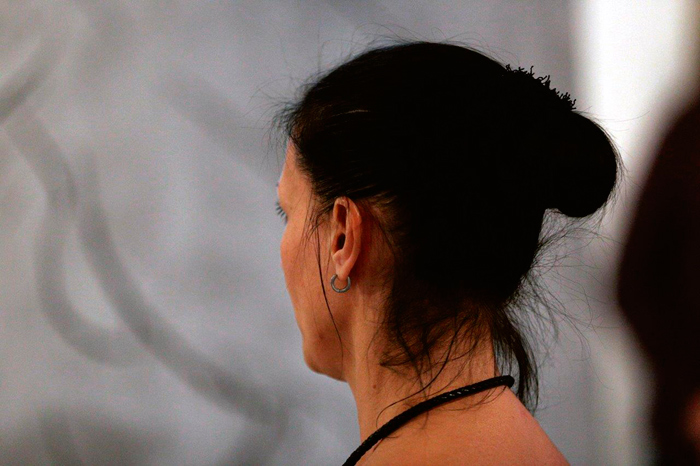
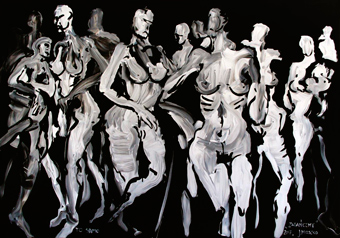
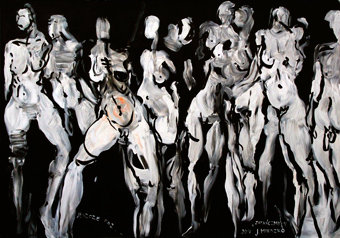
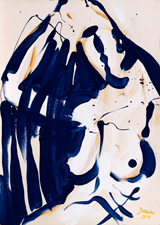
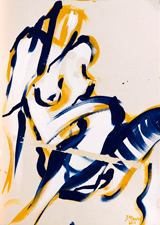
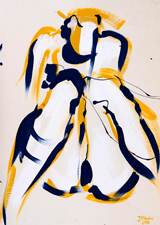
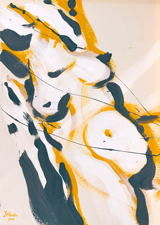
![Joanna Mieszko-Nita - Born in 1969 in Trzcińsko-Zdrój. Graduated from Państwowa Wyższa Szkoła Sztuk Plastycznych [State School of Fine Art.]s in Poznań. Diploma at the sculpting faculty headed by professor Józef Petruk in 1996. Her diploma work – a sculpture set in limestone entitled “Zmagania” [Struggles] – is displayed at Malta lake in Poznań.](https://galeriaart.pl/artists/img/mieszko-nita_profile.jpg)
